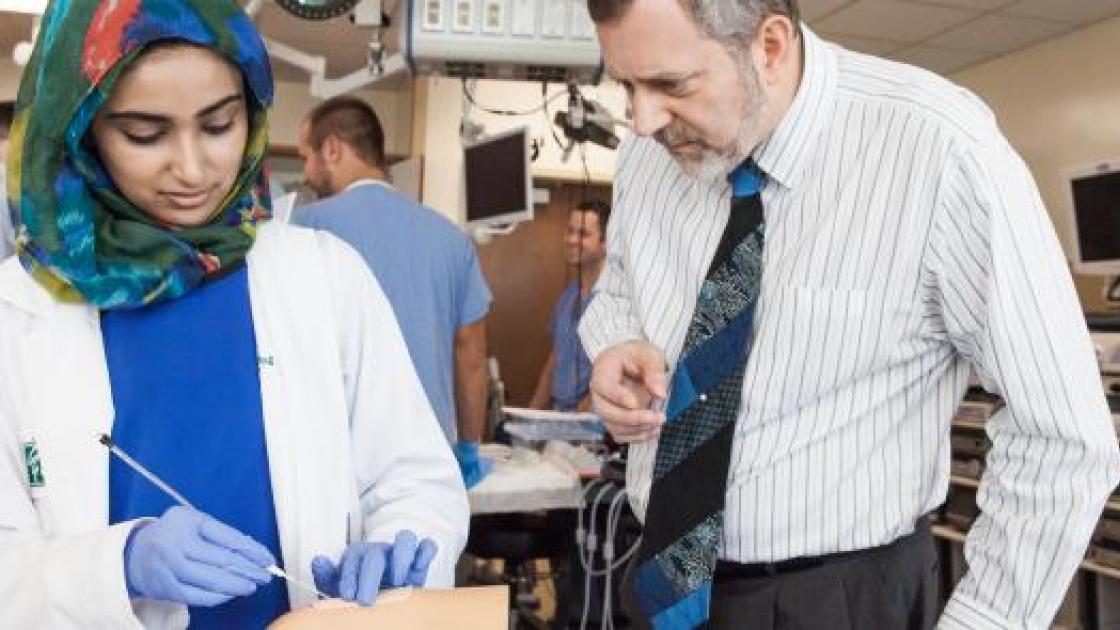
Innovations
SIU School of Medicine has been noted as an innovative medical school program nationally in the United States. SIU School of Medicine was one of the first medical schools to incorporate Problem-based Learning (PBL) and Standardized Patients in the curriculum. The current and ongoing innovative projects in the Department of Medical Education are listed below.
Problem-Based Learning
Problem-based learning (PBL) is a student-centered pedagogy in which students learn about a subject in the context of complex, and realistic problems. (In the case of medical professional schools, this is done with the presentation of a patient case.) The goals of PBL are to help students develop flexible knowledge, effective problem solving skills, self-directed learning, effective collaboration skills and intrinsic motivation. Working in groups, students identify what they already know, what they need to know, and how and where to access new information that may lead to resolution of the problem. The role of the instructor (known as the tutor in PBL) is that of facilitator of learning who provides appropriate support of the process, modeling of the process, and monitoring of learning. PBL was pioneered in medical school in the late 1960s by Howard Barrows and his colleagues.
Standardized Patients
Standardized Patients (SPs) have been used for teaching and assessing medical students at Southern Illinois University (SIU) School of Medicine since the late 1970's. In the mid-1980's, under the direction of Dr. Howard Barrows, the use of SPs in assessment was expanded to include a 15 patient clinical practice exam (CPX) in the senior year. This examination served as part of the stimulus for the development of the SP Project at the National Board of Medical Examiners and for the Macy consortia Project in the early-mid 1990s.
Diagnostic Justifications
The how and where students acquire clinical reasoning skills in medical schools is not understood well. Dr. Klamen has instituted a diagnostic justification exercise/question into clinical competency examinations given in all four years of SIU's medical school, to try to better understand how students think about a differential diagnosis, and the process by which they reason clinically.
Longitudinal Performance Assessment
The Longitudinal Performance Assessment Examination is a paper and pencil, multiple choice format examination given to medical students at the beginning of each of their four years of medical school training. The purpose of the examination is to measure students' clinical reasoning skills and the growth of same across the medical school curriculum. This examination has been in use since 2005, and has been adopted by 5 other medical schools for use in their curricula as well.
BID Model for Teaching in the Operating Room
A structured approach to teaching in the operating room based on educational principles.
SUCCEED
A year-long faculty development seminar series geared explicitly to the needs of new faculty members.
Tutor Tune-up
Quarterly faculty development offerings focused on assisting PBL tutors in developing and maintaining their tutoring skills.
Consultation Conference
A model for collaboration among primary care providers and child psychiatrists.
Critical Clinical Competencies (CCC) Curriculum
In the CCC curriculum, students watch a physician and standardized patient enact a history and physical examination sequence. The video stops at intervals and asks the student his/her current differential diagnosis. After the student has typed in his or her reasoning, a video-recorded panel discussion among physicians from different specialties considers the same data as just seen by the student, and generates an expert list of differential diagnoses, role modeling expert reasoning. The student then is asked to compare his/her differential with that of the panel before moving on to the next section of the history and/or physical examination. This engages students by allowing them to compare their clinical reasoning to the thinking of practicing physicians evaluating the same cases. The videos allow students to ‘see’ the thinking of physicians--a goal that is frequently espoused in medical education theory but rarely systematically accomplished for all students in practice. It also freed the clerkship year to be unapologetically idiosyncratic and opportunistic, since all students encounter all 144 diagnoses during the CCCs. Learn more about the CCCs here, or view a demo here.
